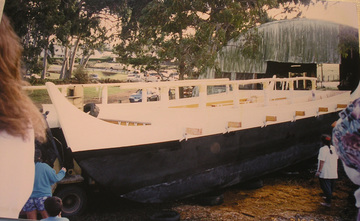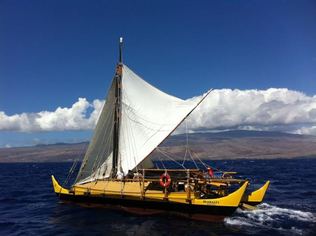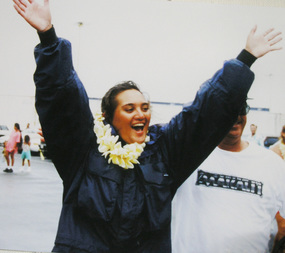
The Hawaiian-style family and community gathering which included two hours of music, chant and hula, was a celebration of roots, place, and family, or in other words, ‘Makali`i Magic’. And indeed it was magical; heart piercing numbers such as Hi`ilawe, interspersed with the hilarity and sharp wit of Kaumakaiwa. But mostly it was a celebration of Makali`i’s journey, begun more than 20 years ago, and all the personal odysseys of those who made it possible.

Like a queen being prepared for her coronation, she received the final touches before her great journey. “Tiger Esperi and Uncle Keoki Manu buffed out the canoe the night before, all the way up to 2 a.m. Uncle Keoki painted her name on because they didn't want her to go out of the warehouse without her name,” said Bertelmann.

One can almost imagine the dragon spirit within her hulls, resting confidently as she traveled to her home on the ocean. “This long line like ants went from Waimea down to Waikoloa and Ka'ahumanu Highway and then to the harbor. Everything we had done up to that particular moment, those 12 hours days, you could really just feel the release of it,” said Bertelmann.

The dream of Makali`i began in Waimea with Clay and Shorty Bertelmann, and her birth came about through the work of ranching families, Waimea School students and community members. “You had all these local families involved: the Puhis, the Case family, the Solomans, the Pahaluas. You had families who were coming in either before they started work or after work. There was just this great outpouring of community to build this canoe. And you had the kupuna like Aunty Marie Soloman, Uncle Sonny Soloman, Robert Keakealani, Clarence Mederios and Mau Piailug. The aumakua (ancestors), they were telling us the community surrounds the canoe,” said Pwo (master) Navigator, Chadd Paishon.

That first night, “nobody planned for anybody to come to work on the canoe but then cars just started coming,” said Bertelmann. “A lot of them were UH students and community members who knew that she was going into the water. That was all attributed to Uncle Keoki Manu. He worked so hard to make sure the community throughout the whole of Hawai`i and the South Pacific knew that she was being birthed.”
 First Crew: Mike Manu, Chadd Paishon, Clay Bertelmann, Billy Richards, John Shore, Tiger Espere, Shorty Bertelmann, Ernie Reyes, Darryl Lupulapu and Maulili Dickson
First Crew: Mike Manu, Chadd Paishon, Clay Bertelmann, Billy Richards, John Shore, Tiger Espere, Shorty Bertelmann, Ernie Reyes, Darryl Lupulapu and Maulili Dickson  Mau Paialug, Shorty and Clay Bertelmann
Mau Paialug, Shorty and Clay Bertelmann “It was the kupuna program and Nā Pua Noe`au (UH gifted and talented) that helped Nā Kālai Wa`a (Hawaii Island canoe organization) blossom as a program entity. We provided the experiential and they wrote the curriculum from that,” said Bertelmann.
 Clay Bertelmann (center) and crew
Clay Bertelmann (center) and crew  Next Generation Crew
Next Generation Crew  Chadd Onohi Paishon
Chadd Onohi Paishon What has emerged with Makali`i over the last 20 years has charted a course to a viable future. “Our canoe, our wa'a, is a bridge that continues to allow us to connect, if we choose to continue to walk across that bridge,” said Paishon. “We are able to do those things because we understand what it takes. We understand the part that we play. Each individual comes together to understand that we are responsible for one another. When we travel to these tiny islands, we share in this common understanding that it takes all of us. It takes this common thread of responsibility for one another, for our wa'a, for our moku (island) that will allow us to go far into the future.” Kekuhi summed it up from the concert stage: “Live your truth. It’s a universal journey of all of us, whether we’re on the wa'a or just right here.”


 RSS Feed
RSS Feed
